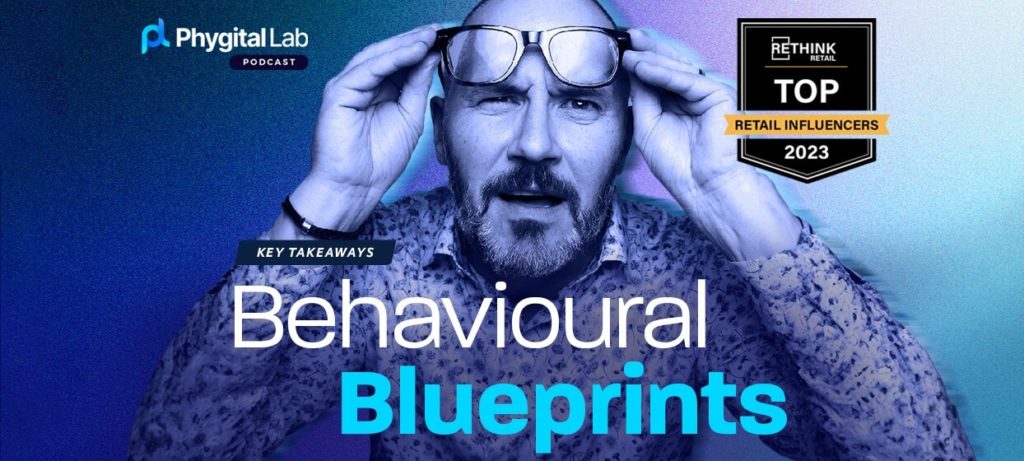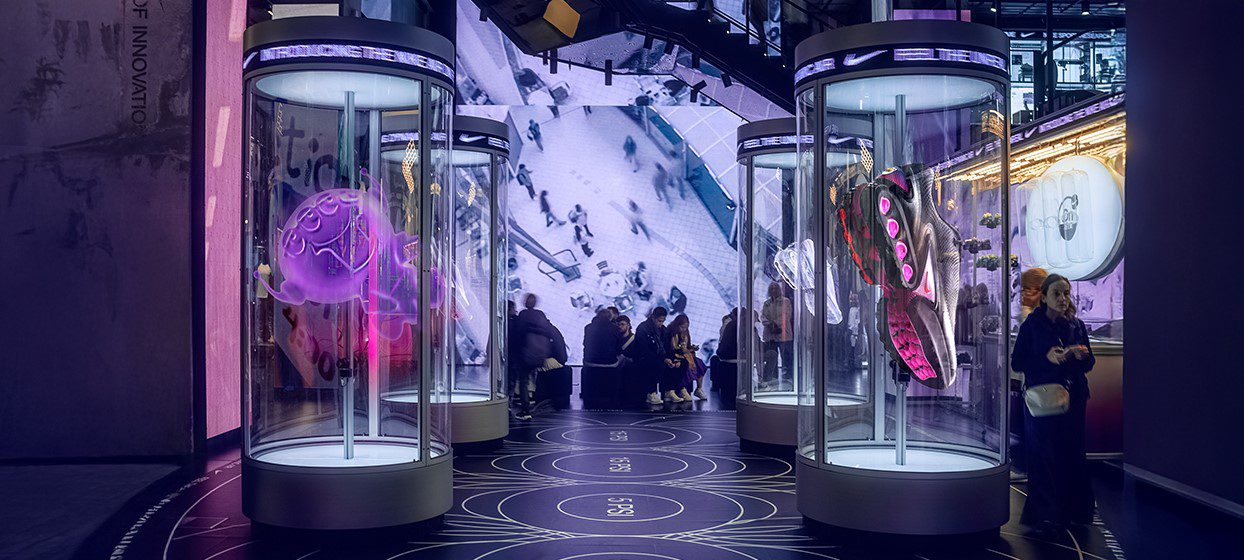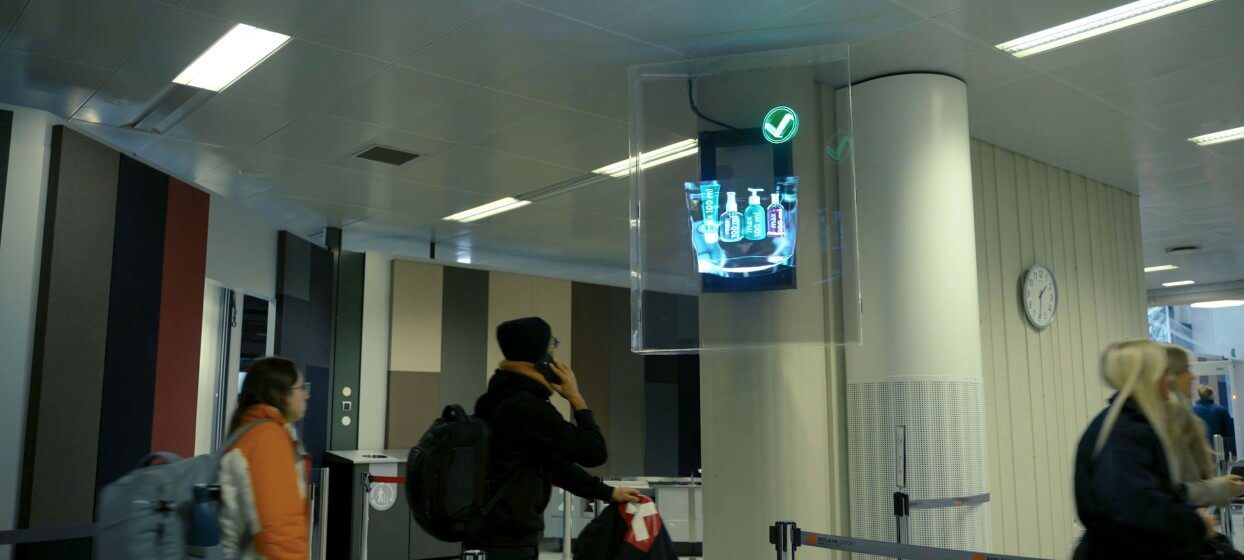
HYPERVSN 3D Catalog
USD 1,200
Qty

HYPERVSN 3D Catalog
USD 1,200
Qty

HYPERVSN 3D Catalog
USD 1,200
Qty
Cart Subtotal:
USD 3,600

HYPERVSN
Marketing Department
“If you understand human behaviour, you’re 90% of the way there to designing an effective retail space.” says Ian Scott, co-founder of the Rema Report and Retail Strategist extraordinaire. “So the more you can understand about [the] principles of human behaviour and decision making, the better you can be. […] The customer [that] comes in one day that loves you, will hate something the next day and you’ve changed nothing. It’s just what’s going on in their head, [what’s happening in] their lives”.
In episode 3 of The Phygital Lab podcast, ‘Behavioural Blueprints’, host Tony Madden and Ian discuss the evolution of retail design and the psychology behind the strategy, looking at how things have changed since the Pandemic, (if indeed they have at all), and the ever growing importance of understanding the motivations behind your customers. Full of insight, relevant experience and brutally honest industry truths, let’s take a look at some of the key takeaways from their illuminating conversation.
“To me, COVID proved that we don’t change much. You know, the moment shops open, we flock back, like we flock back to restaurants and cinemas and holidays and haircuts. […] The Chinese came up with that phrase, ‘revenge shoppers’, [but] all it does to me is reflect the human behavioural aspect of that. […] We rushed back to do all of the things that were social interaction. It just endorses [to] any behavioural psychologist […] that we are social creatures. So embrace that and use it. […] ‘Use […] technology to enhance the unique aspects of the store’ is probably the simplest way of saying [it, but] don’t lose sight of those unique aspects.” After over 20 years looking at human behaviour in Retail, Ian’s fresh take on what happened to the sector post-COVID could be seen as controversial.
An ONS survey in 2022 found that online spending is still markedly higher than it was before the pandemic hit, with 27% of shoppers deciding to go online against the 20% surveyed pre-COVID. Ian’s insight into human behaviour however is incredibly relevant here and now, as brands make a significant effort to increase their high street stores’ footfall by injecting new and innovative technologies into their retail design. But the core concern that brands need to ensure remains at the heart of their design is the customer’s desire to be social, and interact with the brand in relevant and unique ways. Unique is what makes brands stand out from one another, and in this social age where customers are sharing, TikTok-ing and instagramming their shopping journeys, brands that can bring a social & sharable aspect to their stores, whether via digital try-on mirrors or augmented reality, will see huge increases in footfall, brand awareness and revenue.
Stepping out their comfort zone is where brands will find the most reward when it comes to Retail Design. Looking past the tried & true methods of understanding the pillars of the company, what the ethos behind their product is, striving to innovate means allowing for a significant amount of risk in the process, expecting failure and even welcoming it.
The very nature of innovation is the unexpected, the untested, and enabling teams to truly think outside the box in meaningful ways will enhance and embolden brands to create truly unique and relevant retail experiences that drive brand advocacy to new heights. Too often you see copycat initiatives being rolled out across Retail brands, assuming that because something works for their competition it will work for them as well. This is a great way to create a lack of interest and boredom within your customer-base, as you’re not looking at the ways in which your brand is different, you’re just trying to replicate the same effect. Failure isn’t something to shy away from in business, in fact, Ian believes it’s something that brands should welcome; “I would say on average, 50% of innovation should fail. Otherwise, you’re not trying hard enough. And that scares a lot of people. But I often say, you learn more from a failure than you do a success.” Don’t be afraid of the unknown when it comes to business. Embrace it.
Maintaining a consistent and strong tone of voice across your various platforms is a key way to retain customers and keep their business. Not simply looking at the way you say things to appeal to certain demographics (emoji use, slang terms, cultural turns of phrase, etc), but how you keep that consistency across all your channels, from website copy through to social media. Ian explains, “You need a consistent tone of voice. And this is the challenge because you’ve got different teams working on different bits. They need to work together and share information. Otherwise, you get [a] shifting tone of voice.”
A shifting tone of voice equates to a shaky customer base, one which doesn’t know if you’re talking to them or to the teenagers down the hall on any given day. Building this consistency cross-channel, or crafting as Ian calls it, ‘symbiotic retail’, gives you a strong foundation with your audience, and brings this consistency into your retail spaces encouraging increased brand participation, enhanced engagement and a more confident purchasing journey. “I call it symbiotic retail; it’s how the different channels work together because that store experience will lead to online sales. Sephora have recognized this – they say ‘we open a store in a new city, website traffic from that city increases, [and] the store has driven online engagement.”
Nike is another great example of how to make this cross-channel customer experience as effective and as seamless as possible, utilising notifications, consistency and innovative technologies to push the boundaries on customer engagement.
“You go into their House of Innovation stores, [and] you have the app, and I got a buzz on my phone [saying] ‘hi Ian, welcome to Westfield’. It was the Nike app welcoming [me] to the mall saying, ‘we look forward to seeing you in the store’. [A] Great way of navigating you in. And then you go in and [using the app] you can scan products, learn about them, buy them [, and] It […] knows your size from your previous buying history. So that‘s connectivity; […] Same tone of voice, same product, same availability, same price.”
– Ian Scott, co-founder of the Rema ReportAs a consumer, you’re bombarded with marketing messaging all day, every day, but when a brand maintains consistency with their tone of voice using modern technologies and relevant activations when you’re near or in-store, it creates a seamless and enjoyable experience for the customer that when done right, makes their buying journey much easier and far more enjoyable. As a consumer, you don’t stand there thinking about the various platforms you’re using, you just want to get the product you’re after in the fastest and most appealing fashion possible – as retail experience designers, understanding how customers engage with your brand over several different platforms enhances your marketing strategy tenfold.
The Nike House of Innovation store in Paris also recently got an upgrade with HYPERVSN 3D holographics for their latest Air Max Dn’s release, which further showcases Nike’s commitment to innovation when it comes to integrating new technologies to enhance their customers’ experience. Incredibly appealing to see and ceaselessly creative.
Somewhere in the marketing mix of things, individualism was lost. Businesses started looking at grouping customers based on their ages and supposed interest; people over 13 but under 21 are more active on social media therefore they won’t be as interested in politics. People over 25 but under 39 spend more money going to restaurants so they won’t be interested in the latest fast food joint, etc. These presuppositions are harmful and narrow minded, but it’s a classic line of thinking for most brands today. Ian however, wholeheartedly disagrees with this approach; “I mean, the way that Gen Z [and millennials are] categorised is rubbish. Someone just drew a line and [decided] from that day to that day, they’re like this. And then these age groupings don’t reflect socioeconomic or political happenings.”
What he advocates for is a more ‘mission based’ approach; instead of categorising customers into groups based on their ages and supposed interests to target them, look at their motivations behind why they’re shopping with you. “[…] what you need to do is work on missions and need states.
Why is that person shopping? Not who they are, not which bloody car they drive up to the supermarket in. It’s why they’re buying. […] So unless you understand these potential missions, you’re guessing. And I keep saying retail is a very expensive place to go [around] guessing if you get it wrong.” Doing away with age groups and gender types opens up a world of opportunity when looking into why people are motivated to buy from you, and with people’s motivations changing on a daily basis, this allows even more room for innovation and experimentation to really find the WOW factor in your retail experiences.
Remember when retail stores were essentially just spaces for visual merchandisers to populate with products, only really taking into consideration the ‘white space’ left for customers to wander around in? Those times are well and truly gone, with high street stores now becoming experience centres focused on driving engagement with their customers through immersive technologies and personalised content. Visual merchandisers have to take into account a whole host of things these days, from window dressing to attract the highest footfall possible, to injecting human behavioural psychology into their store design to elicit the most powerful reactions and get the most revenue possible.
“You know, I’ve read research saying that [out] of all the people walking down the street, only 3% will notice your window. “And I say it’s quite a chastening statistic, that you build this beautiful window and it’s operating off a 97% failure rate. […] It’s common sense and understanding the dwell time, attention span and basic human behaviour [of your customers]. There are basic levels of communication from visual merchandising, [the] primary role of the window is to get you to go into the store. It can do other things as well, inform and engage, but the primary role is [to encourage people to] come in here because there’s stuff [they] might want to buy.”
– Ian Scott, co-founder of the Rema ReportTapping into the motivations and missions of your customers will heavily influence your visual merchandising, be it through creative product placement or psychology-filled marketing. According to Ian, human behaviour drives this key need for brands, and is what they should be paying the most attention to in order to succeed.
Retail spaces, supermarkets in particular, are becoming hubs of media promoting themselves and key brands they’re working alongside. This new wave of retail space media is confounding experts like Ian, as it’s such a new and hot topic that some brands aren’t using this marketing tactic as effectively as they could be. “Basically you put screens in your store and you sell advertising space and people are seeing the dollar signs because it’s additional revenue that they can create. […] And so you sell the space [, but the problem] with retail media networks, [is that] they’re not thinking of the content, they’re excited about the ad revenue.”
Utilising relevant content in the right places can be a powerful marketing tactic, but failing to understand the psychology behind your customers can lead to unappealing content, confused customers and a drop in revenue. Ian goes on to say “what you need to do is become a strategic partner to work with brands to maximise the effectiveness from your understanding and insight of what works in your store.“ So when it comes time to invest in media networks and selling ads in your retail spaces, you need to take into consideration where this media will be placed, who’s going to see it and its relevance. All three contribute to an enhanced customer buying journey, and can even lead to increased sales thanks to well considered behavioural psychology and understanding the customer’s mission.
An incredibly enlightening conversation from Ian and Tony, looking at how human behaviour is really reshaping the Retail Design landscape of today. The insights shared here are just a small look at their wider conversation, which will really get your creative juices flowing thanks to their relentless enthusiasm for phygital technologies, good humour and focus on psychological customer tactics.
Tune into The Phygital Lab podcast episode 3 ‘ Behavioural Blueprints’ over on our YouTube channel to watch the whole discussion, or listen while you commute to the office on all major podcast platforms.



subscribe

USD 1,200
Qty

USD 1,200
Qty

USD 1,200
Qty
Cart Subtotal:
USD 3,600☎️
“I think innovation is exactly that. It’s trying the new. It’s balancing risk versus reward, but it’s also, even if something fails, it doesn’t necessarily mean that the innovation has failed. And it will probably eight times out of 10 expose new opportunities for that brand, for that retailer.“
– Tony Madden, Managing Director of The Phygital Lab